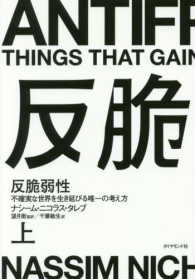- ホーム
- > 洋書
- > ドイツ書
- > Humanities, Arts & Music
- > Arts
- > graphic arts
Description
(Text)
»I color them«David Smith (1906-1965) gilt weithin als einer der herausragenden Künstler des 20. Jahrhunderts. Konzeptuell kam für ihn eine Unterscheidung von Skulptur, Malerei und Zeichnung nicht mehr infrage. Viel von ihrer Kraft ziehen seine Arbeiten aus dieser radikal offenen Herangehensweise. Auch wenn die reine Physis der geschweißten Stahlskulpturen eine stark industrielle Anmutung besitzen, sind ihre Oberflächen stets von gestischen wie haptischen Erscheinungen geprägt, die durch händischen Farbauftrag entstehen. Die Wirkung seiner Arbeit liegt u. a. in seinem Beharren darauf, dass Skulptur dieselbe visuelle Bedeutung wie Malerei und Zeichnung hat, Malerei und Zeichnung dafür dieselbe räumliche Wirkung entfalten. Der vorliegende Katalog erfasst 21 Arbeiten, von den späten 1950er Jahren bis 1965, und dokumentiert so seine Entwicklung mithilfe reichhaltigen Bildmaterials, darunter auch historische Aufnahmen aus dem Archiv des Estate von David Smith. David Smith, geboren 1906 in Decatur, Indiana, besuchte zunächst das College u. a. an der Ohio Universität und zog 1926 nach New York, wo er ein Studium bei der Art Students League begann. In den frühen 1930er Jahren fokussierte er sich ganz auf Skulptur, schweißte Konstruktionen aus gefundenen Objekten und geschmiedetem Metall zusammen. 1940 übersiedelte er nach Bolton Landing, außerhalb von New York gelegen, und richtete sich dort ein mit industriellen Materialien und Werkzeugen reichlich ausgestattetes Atelier in einem Fabrikgebäude ein. Seit den späten 1950er Jahren stellte er in der Hügellandschaft rund um sein Atelier monumentale Arbeiten auf. 1965 starb David Smith bei einem Autounfall nahe Bennington, Vermont. David Smith hat Künstlern wie John Chamberlain, Mark di Suvero, Donald Judd und Richard Serra den Weg gewiesen, war doch er es, der den Ort der Produktion von Skulpturen aus den Beschränkungen des Künstlerateliers des 19. Jahrhunderts und der Kunstgießereien befreit und mit dem industriellen Kontext des 20. Jahrhunderts verbunden hat.Ausstellung:Hauser & Wirth Zürich, 12/6-18/9/2016
(Text)
»I color them«David Smith (1906-1965) is widely considered one of the foremost artists of the 20th century. For the artist, there was no conceptual boundary between sculpture, painting, and drawing. The resulting works derive much of their power from this radically open-ended approach. Whereas the physical qualities of Smith's welded-steel sculptures transmit a strong industrial presence, their surfaces carry gestural and tactile imprints, often of hand-applied paint. The impact of his work results from his insistence that sculpture have the same visual impact as painting and drawing, and that drawing and painting have the same spatial weight as sculpture. Focusing on 20 works from the late 1950s until the artist's untimely and sudden death in 1965, »David Smith: Form in Color« charts the development of these stunning works with extensive illustrations and historic images culled from the archives of The Estate of David Smith. David Smith, born in 1906 in Decatur, Indiana, studiedat the Art Students League in New York. In the early 1930s he began to focus on sculpture, creating welded constructions by using found objects and forged metal. Smith moved permanently to Bolton Landing, in upstate New York, in 1940, where he created a factory-like studio stocked with industrial tools and materials. From the late 1950s he filled the rolling hills that surrounded his studio with monumental works. He died in a car accident near Bennington, Vermont, in 1965. Smith paved the way for such artists as John Chamberlain, Mark di Suvero, Donald Judd, and Richard Serra by moving the site of sculpture's construction from the 19th-century confines of the artist's atelier and the fine-art foundry, into the expansive, industrial context of the 20th century.Exhibition:Hauser & Wirth Zurich, 12/6-18/9/2016








